Evaluation and Bias Correction of ECMWF Extended-Range Precipitation Forecasts over the Confluence of Asian Monsoons and Westerlies Using the Linear Scaling Method
Abstract
1. Introduction
2. Materials and Methods
2.1. Study Area
2.2. Data
- (1)
- Forecasted precipitation data: The Atmospheric Model Ensemble Extended Forecast (Set VI-ENS extended) from the ECMWF IFS was utilized as the precipitation forecast. This product was available once a week before June 30, 2014, twice a week thereafter, and then daily after June 27, 2023. It provided a lead time of up to 46 days (32 days prior to July 2014) and a spatial resolution of 0.2° for the initial 15 days, followed by 0.4° for subsequent days. A total of 1398 precipitation forecast data points were collected for the study area from 13 March 2008 (its inception date) to 26 June 2023. Data up to 31 December 2020 were utilized for the calibration of the correction factor, while subsequent data were employed for validation. In this study, the lead time was uniformly considered to be 32 days. According to the American Meteorological Society’s Glossary of Meteorology [42], this qualifies as a long-term hydrological forecast, as it exceeds one week. In practical hydrological forecasting, the selection and evaluation of ensemble members represent a broad area of investigation, which falls outside the scope of this paper. Importantly, the control forecast is generated with the best available data and is statistically superior to any individual perturbed member; therefore, this study focuses only on the control forecast rather than other perturbed ensemble members.
- (2)
- Observed precipitation data: Given the limited availability of measured data in the study area, grid precipitation products derived from observation sites or remote sensing serve as reliable substitutes for hydrological forecasting. The observation grid data are primarily interpolated from site-based observation data. However, the spatial representation of meteorological stations across the entire study area is inferior to that in the plains, especially in the western Tibetan Plateau [40]. In contrast, remote sensing data are not constrained by geographical factors, rendering precipitation data obtained from remote sensing signals a more suitable option in regions with limited station coverage [43].
- (3)
- Hydrological data: Daily discharge data from 9 hydrological stations in the three study basins were employed for hydrological model calibration. The data periods for each station were as follows: JiuZhou, Gajiu, and Jinghong in the Upper Mekong basin (1991–2009); Liuku, Jiayuqiao, Jiedaoba, and Gongshan in the Upper Salween basin (2000–2012); and Nuxia and Gongshan in the Brahmaputra River basin (1983–2015).
- (4)
- Other data: Additional inputs for the hydrological model included the MERIT DEM [59] with a spatial resolution of 90 m. Temperature and potential evapotranspiration data were sourced from the ERA5-Land [60]. To account for the period prior to June 2000, when GPM IMERG data became available, precipitation data from ERA5-Land were utilized. The Normalized Difference Vegetation Index (NDVI) and Leaf Area Index (LAI) were derived from the NOAA Climate Data Record (CDR) datasets [61], both of which have a daily temporal resolution and a spatial resolution of 0.05°.
2.3. Bias Evaluation and Correction
2.4. Hydrological Model
3. Results
4. Discussion
4.1. Impact of the Selection of Correction Factors
4.2. Limitations and Future Outlook
5. Conclusions
Author Contributions
Funding
Data Availability Statement
Acknowledgments
Conflicts of Interest
Appendix A
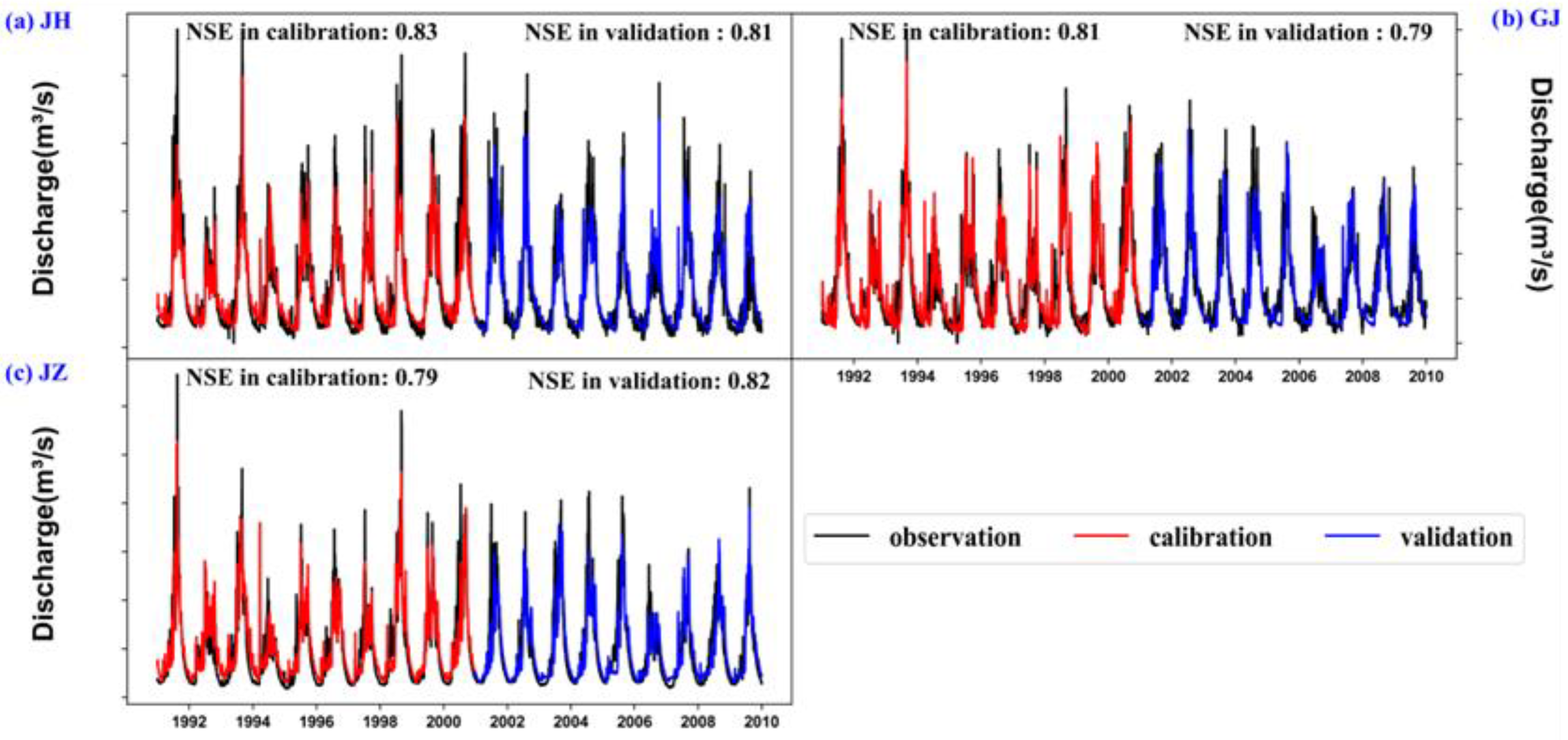
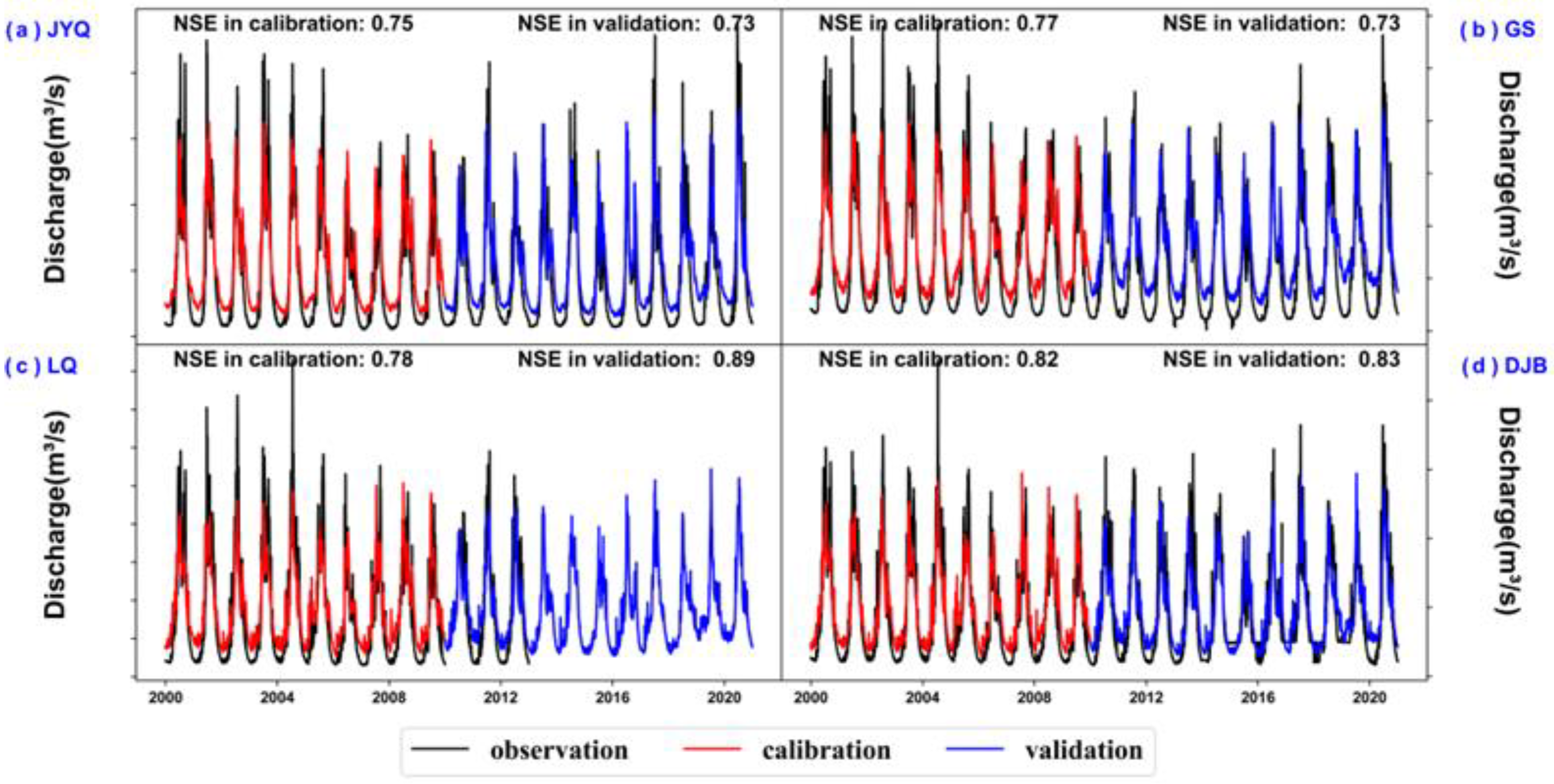
References
- Ng, K.W.; Huang, Y.F.; Koo, C.H.; Chong, K.L.; El-Shafie, A.; Ahmed, A.N. A review of hybrid deep learning applications for streamflow forecasting. J. Hydrol. 2023, 625, 130141. [Google Scholar] [CrossRef]
- Cheng, M.; Fang, F.; Kinouchi, T.; Navon, I.M.; Pain, C.C. Long lead-time daily and monthly streamflow forecasting using machine learning methods. J. Hydrol. 2020, 590, 125376. [Google Scholar] [CrossRef]
- Sun, A.Y.; Wang, D.; Xu, X. Monthly streamflow forecasting using Gaussian process regression. J. Hydrol. 2014, 511, 72–81. [Google Scholar] [CrossRef]
- Ni, L.; Wang, D.; Singh, V.P.; Wu, J.; Wang, Y.; Tao, Y.; Zhang, J. Streamflow and rainfall forecasting by two long short-term memory-based models. J. Hydrol. 2019, 583, 124296. [Google Scholar] [CrossRef]
- Gomez, M.; Sharma, S.; Reed, S.; Mejia, A. Skill of ensemble flood inundation forecasts at short-to medium-range timescales. J. Hydrol. 2019, 568, 207–220. [Google Scholar] [CrossRef]
- Sharma, S.; Raj Ghimire, G.; Siddique, R. Machine learning for postprocessing ensemble streamflow forecasts. J. Hydroinform. 2023, 25, 126–139. [Google Scholar] [CrossRef]
- Yang, C.; Yuan, H.; Su, X. Bias correction of ensemble precipitation forecasts in the improvement of summer streamflow prediction skill. J. Hydrol. 2020, 588, 124955. [Google Scholar] [CrossRef]
- Su, X.; Yuan, H.; Zhu, Y.; Luo, Y.; Wang, Y. Evaluation of TIGGE ensemble predictions of Northern Hemisphere summer precipitation during 2008–2012. J. Geophys. Res. Atmos. 2014, 119, 7292–7310. [Google Scholar] [CrossRef]
- Lavers, D.A.; Harrigan, S.; Prudhomme, C. Precipitation Biases in the ECMWF Integrated Forecasting System. J. Hydrometeor. 2021, 22, 1187–1198. [Google Scholar] [CrossRef]
- Li, W.; Hu, S.; Hsu, P.C.; Guo, W.; Wei, J. Systematic bias of Tibetan Plateau snow cover in subseasonal-to-seasonal models. Cryosphere 2020, 14, 3565–3579. [Google Scholar] [CrossRef]
- Yuan, W.H.; Hu, X.L.; Li, Y.S. Evaluation of the hourly rainfall in the ECMWF forecasting over southwestern China. Meteor. Appl. 2020, 27, e1936. [Google Scholar] [CrossRef]
- Xie, Y.; Yuan, W.; Hu, X. Evaluation of hourly forecasts of the European Centre for Medium-Range Weather Forecasts over the southeastern extension of the Tibetan Plateau. Int. J. Climatol. 2022, 42, 5232–5241. [Google Scholar] [CrossRef]
- Liu, C.; Sun, J.; Yang, X.; Jin, S.; Fu, S. Evaluation of ECMWF precipitation predictions in China during 2015–18. Weather Forecast. 2021, 36, 1043–1060. [Google Scholar] [CrossRef]
- Verkade, J.S.; Brown, J.D.; Reggiani, P.; Weerts, A.H. Post-processing ECMWF precipitation and temperature ensemble reforecasts for operational hydrologic forecasting at various spatial scales. J. Hydrol. 2013, 501, 73–91. [Google Scholar] [CrossRef]
- Pappenberger, F.; Cloke, H.L.; Balsamo, G.; Ngo-Duc, T.; Oki, T. Global runoff routing with the hydrological component of the ECMWF NWP system. Int. J. Climatol. 2010, 30, 2155–2174. [Google Scholar] [CrossRef]
- Balsamo, G.; Viterbo, P.; Beljaars, A.; den Hurk, B.V.; Hirchi, M.; Betts, A.; Scipal, K. A revised hydrology for the ECMWF model: Verification from field site to terrestrial water storage and impact in the integrated forecast system. J. Hydrometeorol. 2008, 10, 623–643. [Google Scholar] [CrossRef]
- Gneiting, T.; Raftery, A.; Westveld, A.; Goldman, T. Calibrated probabilistic forecasting using ensemble model output statistics and minimum CRPS estimation. Mon. Weather Rev. 2005, 133, 1098–1118. [Google Scholar] [CrossRef]
- Hagedorn, R.; Hamill, T.; Whitaker, J. Probabilistic forecast calibration using ECMWF and GFS ensemble reforecasts. Part I: Two-meter temperatures. Mon. Weather Rev. 2008, 136, 2608–2619. [Google Scholar] [CrossRef]
- Roulin, E.; Vannitsem, S. Postprocessing of Ensemble Precipitation Predictions with Extended Logistic Regression Based on Hindcasts. Mon. Weather Rev. 2012, 140, 874–888. [Google Scholar] [CrossRef]
- Wilks, D.S. Extending logistic regression to provide full-probability-distribution MOS forecasts. Meteorol. Appl. 2009, 16, 361–368. [Google Scholar] [CrossRef]
- Block, P.J.; Souza-Filho, F.A.; Sun, L.; Kwon, H.H. A Stream-flow Forecasting Framework using Multiple Climate and Hydrological Models. J. Am. Water Resour. Assoc. 2009, 45, 828–843. [Google Scholar] [CrossRef]
- Déqué, M.; Rowell, D.P.; Lüthi, D.; Giorgi, F.; Christensen, J.H.; Rockel, B.; Jacob, D.; Kjellström, E.; de Castro, M.; Van Den Hurk, B. An intercomparison of regional climate simulations for Europe: Assessing uncertainties in model projections. Clim. Change 2007, 81, 53–70. [Google Scholar] [CrossRef]
- Kim, D.I.; Kwon, H.H.; Han, D. Bias correction of daily precipitation over South Korea from the long-term reanalysis using a composite Gamma-Pareto distribution approach. Hydrol. Res. 2019, 50, 1138–1161. [Google Scholar] [CrossRef]
- Sloughter, J.M.L.; Raftery, A.E.; Gneiting, T.; Fraley, C. Probabilistic quantitative precipitation forecasting using Bayesian Model Averaging. Mon. Weather Rev. 2007, 135, 3209–3220. [Google Scholar] [CrossRef]
- Hamill, T.M.; Hagedorn, R.; Whitaker, J.S. Probabilistic Forecast Calibration Using ECMWF and GFS Ensemble Reforecasts. Part II: Precipitation. Mon. Weather Rev. 2008, 136, 2620–2632. [Google Scholar] [CrossRef]
- Ma, Y.; Yang, Y.; Han, Z.; Tang, G.; Maguire, L.; Chu, Z.; Hong, Y. Comprehensive evaluation of Ensemble Multi-Satellite Precipitation Dataset using the Dynamic Bayesian Model Averaging scheme over the Tibetan plateau. J. Hydrol. 2018, 556, 634–644. [Google Scholar] [CrossRef]
- Yuan, H.; Gao, X.; Mullen, S.L.; Sorooshian, S.; Du, J.; Juang, H.-M.H. Calibration of probabilistic quantitative precipitation forecasts with an artificial neural network. Weather Forecast. 2007, 22, 1287–1303. [Google Scholar] [CrossRef]
- Wilks, D.S.; Hamill, T.M. Comparison of ensemble-MOS methods using GFS reforecasts. Mon. Weather Rev. 2007, 135, 2379–2390. [Google Scholar] [CrossRef]
- Mendez, M.; Maathuis, B.; Hein-Griggs, D.; Alvarado-Gamboa, L.-F. Performance Evaluation of Bias Correction Methods for Climate Change Monthly Precipitation Projections over Costa Rica. Water 2020, 12, 482. [Google Scholar] [CrossRef]
- Crochemore, L.; Ramos, M.H.; Pappenberger, F. Bias correcting precipitation forecasts to improve the skill of seasonal streamflow forecasts. Hydrol. Earth Syst. Sci. 2016, 20, 3601–3618. [Google Scholar] [CrossRef]
- Wang, P.; Clemens, S.; Beaufort, L.; Braconnot, P.; Ganssen, G.; Jian, Z.; Kershaw, P.; Sarnthein, M. Evolution and variability of the Asian monsoon system: State of the art and outstanding issues. Quat. Sci. Rev. 2005, 24, 595–629. [Google Scholar] [CrossRef]
- Tada, R.; Zheng, H.; Clift, P.D. Evolution and variability of the Asian monsoon and its potential linkage with uplift of the Himalaya and Tibetan Plateau. Prog. Earth Planet. Sci. 2016, 3, 4. [Google Scholar] [CrossRef]
- Ma, Q.; You, Q.; Ma, Y.; Cao, Y.; Zhang, J.; Niu, M.; Zhang, Y. Changes in cloud amount over the Tibetan Plateau and impacts of large-scale circulation. Atmos. Res. 2021, 249, 105332. [Google Scholar] [CrossRef]
- Lu, H.; Zheng, D.; Yang, K.; Yang, F. Last-decade progress in understanding and modeling the land surface processes on the Tibetan Plateau. Hydrol. Earth Syst. Sci. 2020, 24, 5745–5758. [Google Scholar] [CrossRef]
- Zhang, F.; Thapa, S.; Immerzeel, W.; Zhang, H.; Lutz, A. Water availability on the Third Pole: A review. Water Secur. 2019, 7, 100033. [Google Scholar] [CrossRef]
- Li, S.F.; Valdes, P.J.; Farnsworth, A.; Davies-Barnard, T.; Su, T.; Lunt, D.J.; Spicer, R.A.; Liu, J.; Deng, W.Y.D.; Huang, J.; et al. Orographic evolution of northern Tibet shaped vegetation and plant diversity in eastern Asia. Sci. Adv. 2021, 7, eabc7741. [Google Scholar] [CrossRef]
- Guo, D.; Wang, H. The significant climate warming in the northern Tibetan Plateau and its possible causes. Int. J. Climatol. 2012, 32, 1775–1781. [Google Scholar] [CrossRef]
- Kuang, X.; Jiao, J.J. Review on climate change on the Tibetan Plateau during the last half century. J. Geophys. Res. Atmos. 2016, 121, 3979–4007. [Google Scholar] [CrossRef]
- American Meteorological Society. Long-Term Hydrological Forecast. Glossary of Meteorology. 2025. Available online: https://glossary.ametsoc.org/wiki/Long-term_hydrological_forecast (accessed on 10 May 2025).
- Li, D.; Yang, K.; Tang, W.; Li, X.; Zhou, X.; Guo, D. Characterizing precipitation in high altitudes of the western Tibetan plateau with a focus on major glacier areas. Int. J. Climatol. 2020, 40, 5114–5127. [Google Scholar] [CrossRef]
- Zheng, H.; Yang, Q.; Cao, S.; Clift, P.D.; He, M.; Kano, A.; Sakuma, A.; Xu, H.; Tada, R.; Jourdan, F. From desert to monsoon: Irreversible climatic transition at ~36 Ma in southeastern Tibetan Plateau. Prog. Earth Planet. Sci. 2022, 9, 12. [Google Scholar] [CrossRef]
- Yao, T.; Thompson, L.; Yang, W.; Yu, W.; Gao, Y.; Guo, X.; Yang, X.; Duan, K.; Zhao, H.; Xu, B.; et al. Different glacier status with atmospheric circulations in Tibetan Plateau and surroundings. Nat. Clim. Change 2012, 2, 663–667. [Google Scholar] [CrossRef]
- Huang, L.; Chen, J.; Yang, K.; Yang, Y.; Huang, W.; Zhang, X.; Chen, F. The northern boundary of the Asian summer monsoon and division of westerlies and monsoon regimes over the Tibetan Plateau in present-day. Sci. China Earth Sci. 2023, 66, 882–893. [Google Scholar] [CrossRef]
- Tan, J.; Huffman, G.J.; Bolvin, D.T.; Nelkin, E.J. Diurnal cycle of IMERG V06 precipitation. Geophys. Res. Lett. 2019, 46, 13584–13592. [Google Scholar] [CrossRef]
- Huffman, G.J.; Bolvin, D.T.; Braithwaite, D.; Hsu, K.; Joyce, R.; Kidd, C.; Nelkin, E.J.; Sorooshian, S.; Tan, J.; Xie, P. NASA Global Precipitation Measurement (GPM) Integrated Multi SatellitE Retrievals for GPM (IMERG); Algorithm Theoretical Basis Document (ATBD) Version 06; National Aeronautics and Space Administration (NASA): Washington, DC, USA, 2019. [Google Scholar]
- Ma, L.; Zhao, L.; Tian, L.; Yuan, L.M.; Xiao, Y.; Zhang, L.L.; Zou, F.D.; Qiao, Y.P. Evaluation of the integrated multi-satellite retrievals for global precipitation measurement over the Tibetan Plateau. J. Mt. Sci. 2019, 16, 1500–1514. [Google Scholar] [CrossRef]
- Zhang, W.; Di, Z.; Liu, J.; Zhang, S.; Liu, Z.; Wang, X.; Sun, H. Evaluation of five satellite-based precipitation products for extreme rainfall estimations over the Qinghai-Tibet Plateau. Remote Sens. 2023, 15, 5379. [Google Scholar] [CrossRef]
- Zhang, S.; Wang, D.; Qin, Z.; Zheng, Y.; Guo, J. Assessment of the GPM and TRMM precipitation products using the rain gauge network over the Tibetan Plateau. J. Meteorol. Res. 2018, 32, 324–336. [Google Scholar] [CrossRef]
- Lei, H.; Li, H.; Zhao, H.; Ao, T.; Li, X. Comprehensive evaluation of satellite and reanalysis precipitation products over the eastern Tibetan plateau characterized by a high diversity of topographies. Atmos. Res. 2021, 259, 105661. [Google Scholar] [CrossRef]
- Muñoz-Sabater, J.; Dutra, E.; Agustí-Panareda, A.; Albergel, C.; Arduini, G.; Balsamo, G.; Boussetta, S.; Choulga, M.; Harrigan, S.; Hersbach, H.; et al. ERA5-Land: A state-of-the-art global reanalysis dataset for land applications. Earth Syst. Sci. Data 2021, 13, 4349–4383. [Google Scholar] [CrossRef]
- Wu, X.; Su, J.; Ren, W.; Lü, H.; Yuan, F. Statistical comparison and hydrological utility evaluation of ERA5-Land and IMERG precipitation products on the Tibetan Plateau. J. Hydrol. 2023, 620, 129384. [Google Scholar] [CrossRef]
- Xu, J.; Ma, Z.; Yan, S.; Peng, J. Do ERA5 and ERA5-land precipitation estimates outperform satellite-based precipitation products? A comprehensive comparison between state-of-the-art model-based and satellite-based precipitation products over mainland China. J. Hydrol. 2022, 605, 127353. [Google Scholar] [CrossRef]
- Lyu, Y.; Yong, B.; Huang, F.; Qi, W.; Tian, F.; Wang, G.; Zhang, J. Investigating twelve mainstream global precipitation datasets: Which one performs better on the Tibetan Plateau? J. Hydrol. 2024, 633, 130947. [Google Scholar] [CrossRef]
- Ghimire, U.; Akhtar, T.; Shrestha, N.K.; Paul, P.K.; Schürz, C.; Srinivasan, R.; Daggupati, P. A long-term global comparison of IMERG and CFSR with surface precipitation stations. Water Resour. Manag. 2022, 36, 5695–5709. [Google Scholar] [CrossRef]
- Li, Y.; Wang, W.; Lu, H.; Khem, S.; Yang, K.; Huang, X. Evaluation of three satellite-based precipitation products over the lower Mekong river basin using rain gauge observations and hydrological modeling. IEEE J. Sel. Top. Appl. Earth Obs. Remote Sens. 2019, 12, 2357–2373. [Google Scholar] [CrossRef]
- Nepal, B.; Shrestha, D.; Sharma, S.; Shrestha, M.S.; Aryal, D.; Shrestha, N. Assessment of GPM-Era Satellite Products’ (IMERG and GSMaP) Ability to Detect Precipitation Extremes over Mountainous Country Nepal. Atmosphere 2021, 12, 254. [Google Scholar] [CrossRef]
- Tran, T.N.D.; Nguyen, B.Q.; Zhang, R.; Aryal, A.; Grodzka-Łukaszewska, M.; Sinicyn, G.; Lakshmi, V. Quantification of gridded precipitation products for the streamflow simulation on the Mekong River Basin using rainfall assessment framework: A case study for the Srepok River subbasin, central highland Vietnam. Remote Sens. 2023, 15, 1030. [Google Scholar] [CrossRef]
- Jawad, M.; Bhattacharya, B.; Young, A.; van Andel, S.J. Evaluation of Near Real-Time Global Precipitation Measurement (GPM) Precipitation Products for Hydrological Modelling and Flood Inundation Mapping of Sparsely Gauged Large Transboundary Basins—A Case Study of the Brahmaputra Basin. Remote Sens. 2024, 16, 1756. [Google Scholar] [CrossRef]
- Yamazaki, D.; Ikeshima, D.; Tawatari, R.; Yamaguchi, T.; O’Loughlin, F.; Neal, J.C.; Sampson, C.C.; Kanae, S. A high accuracy map of global terrain elevations. Geophys. Res. Lett. 2017, 44, 5844–5853. [Google Scholar] [CrossRef]
- Muñoz Sabater, J.; ERA5-Land Hourly Data from 1950 to Present. Copernicus Climate Change Service (C3S) Climate Data Store (CDS). 2019. Available online: https://cds.climate.copernicus.eu/datasets/reanalysis-era5-land (accessed on 1 July 2022).
- Eric, V.; Chris, J.; Ivan, C.; Jeff, E.; Ranga, M.; Frederic, B.; Edward, M.; Robert, W.; Martin, C.; NOAA CDR Program. NOAA Climate Data Record (CDR) of Normalized Difference Vegetation Index (NDVI), Version 4; NOAA National Climatic Data Center: Asheville, NC, USA, 2014. [Google Scholar]
- Lenderink, G.; Buishand, A.; Van Deursen, W. Estimates of future discharges of the river Rhine using two scenario methodologies: Direct versus delta approach. Hydrol. Earth Syst. Sci. 2007, 11, 1145–1159. [Google Scholar] [CrossRef]
- Tian, F.; Hu, H.; Lei, Z.; Sivapalan, M. Extension of the Representative Elementary Watershed approach for cold regions via explicit treatment of energy related processes. Hydrol. Earth Syst. Sci. 2006, 10, 619–644. [Google Scholar] [CrossRef]
- Mou, L.; Tian, F.; Hu, H. Artificial neural network model of runoff prediction in high and cold mountainous regions: A case study in the source drainage area of Urumqi River. J. Hydroelectr. Eng. 2009, 28, 64–69. [Google Scholar]
- Sun, Y.; Tian, F.; Yang, L.; Hu, H. Exploring the spatial variability of contributions from climate variation and change in catchment properties to streamflow decrease in a mesoscale basin by three different methods. J. Hydrol. 2014, 508, 170–180. [Google Scholar] [CrossRef]
- Cui, T.; Li, Y.; Yang, L.; Nan, Y.; Li, K.; Tudaji, M.; Hu, H.; Long, D.; Shahid, M.; Mubeen, A.; et al. Non-monotonic changes in Asian Water Towers’ streamflow at increasing warming levels. Nat. Commun. 2023, 14, 1176. [Google Scholar] [CrossRef]
- Lyu, H.; Tian, F.; Zhang, K.; Nan, Y. Water-energy-food nexus in the Yarlung Tsangpo-Brahmaputra River Basin: Impact of mainstream hydropower development. J. Hydrol. Reg. Stud. 2023, 45, 101293. [Google Scholar] [CrossRef]
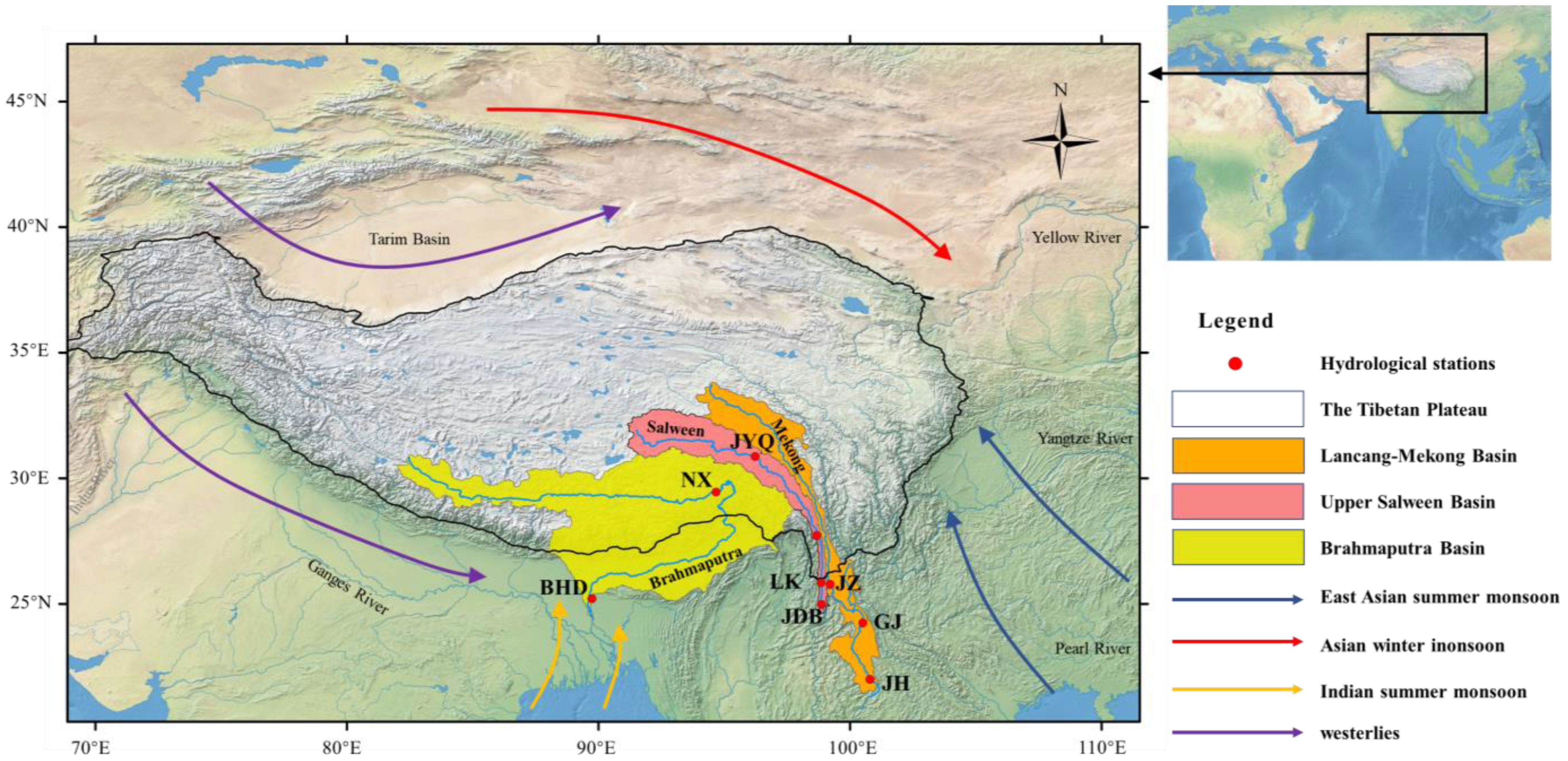
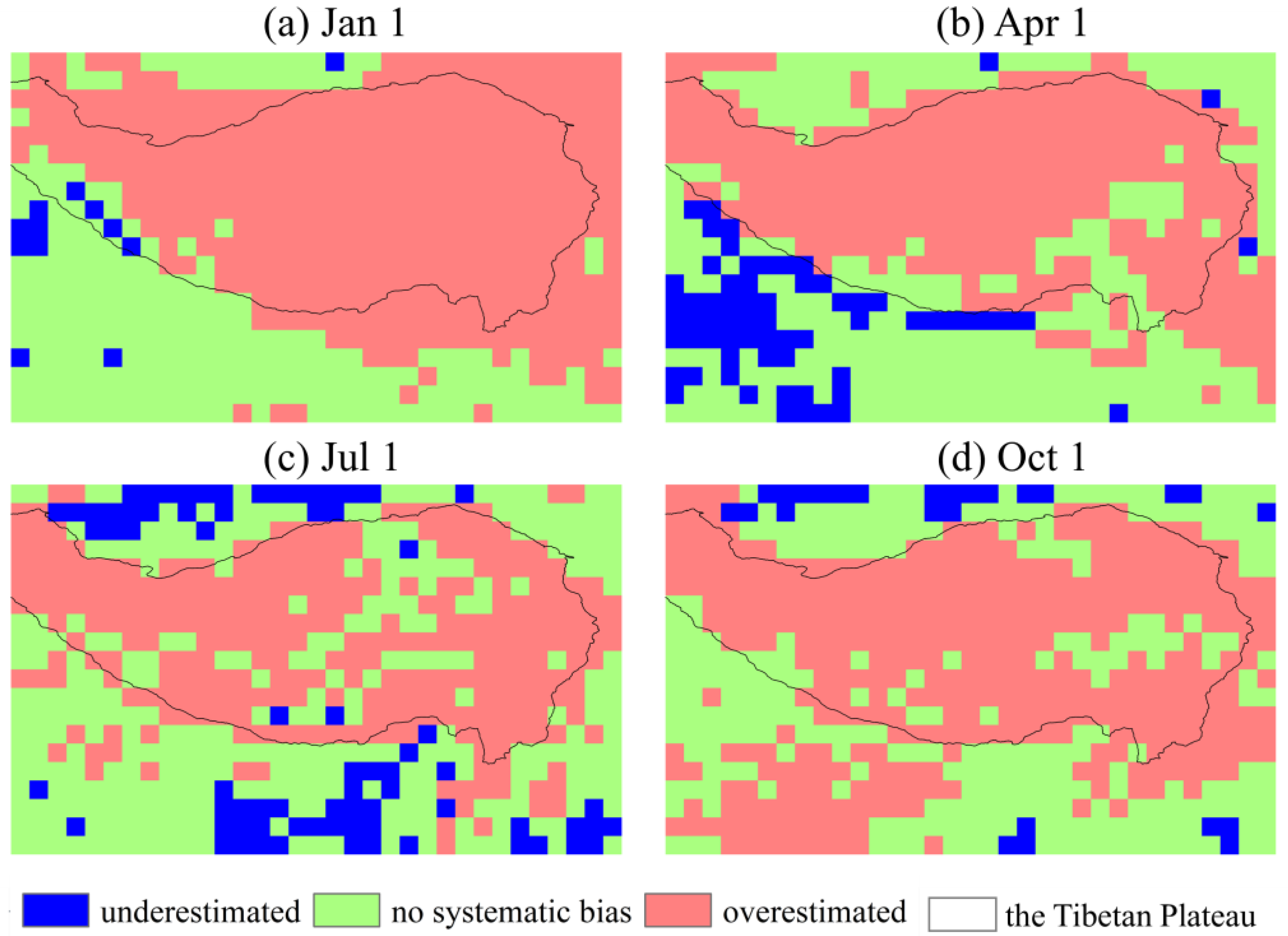
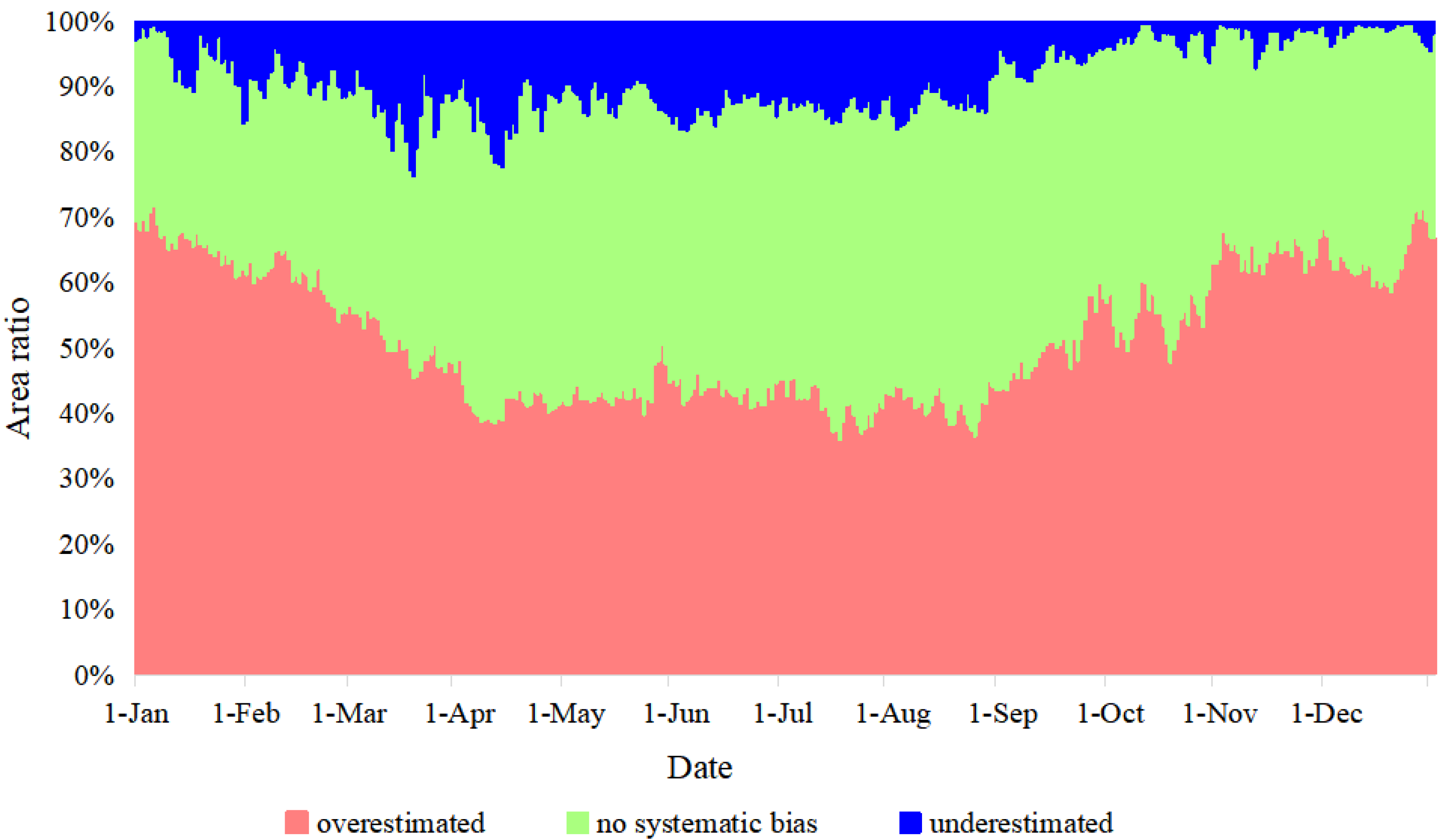
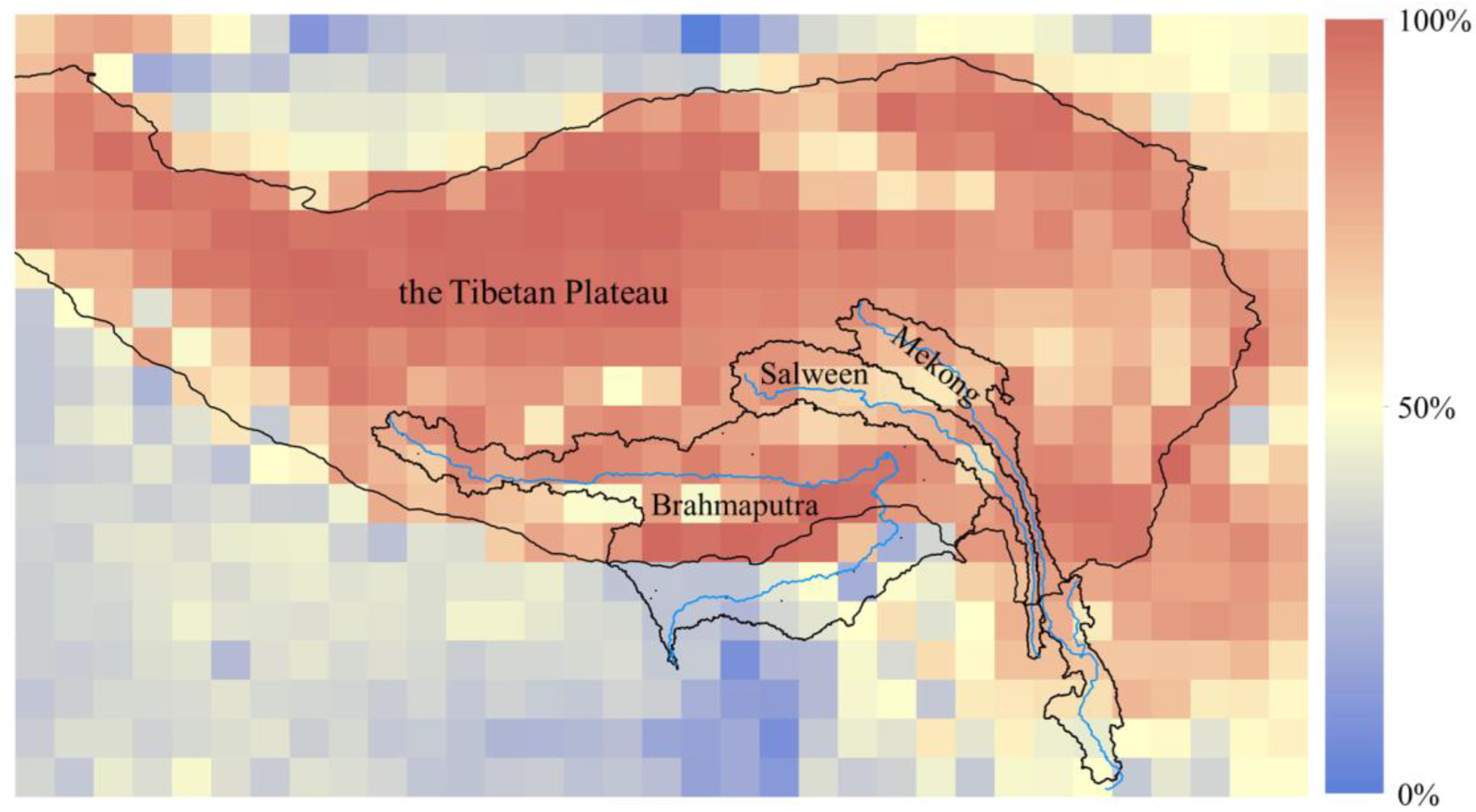
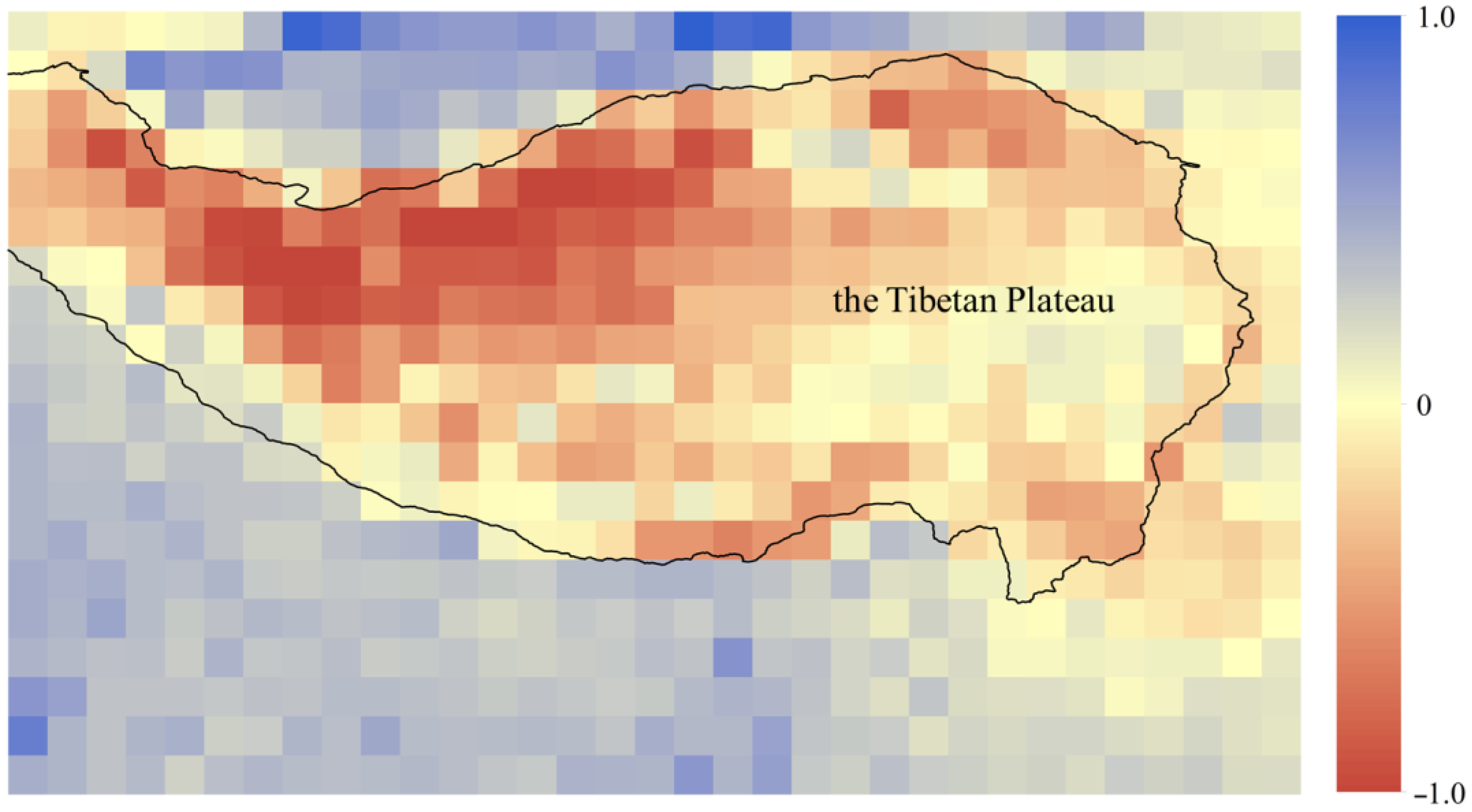
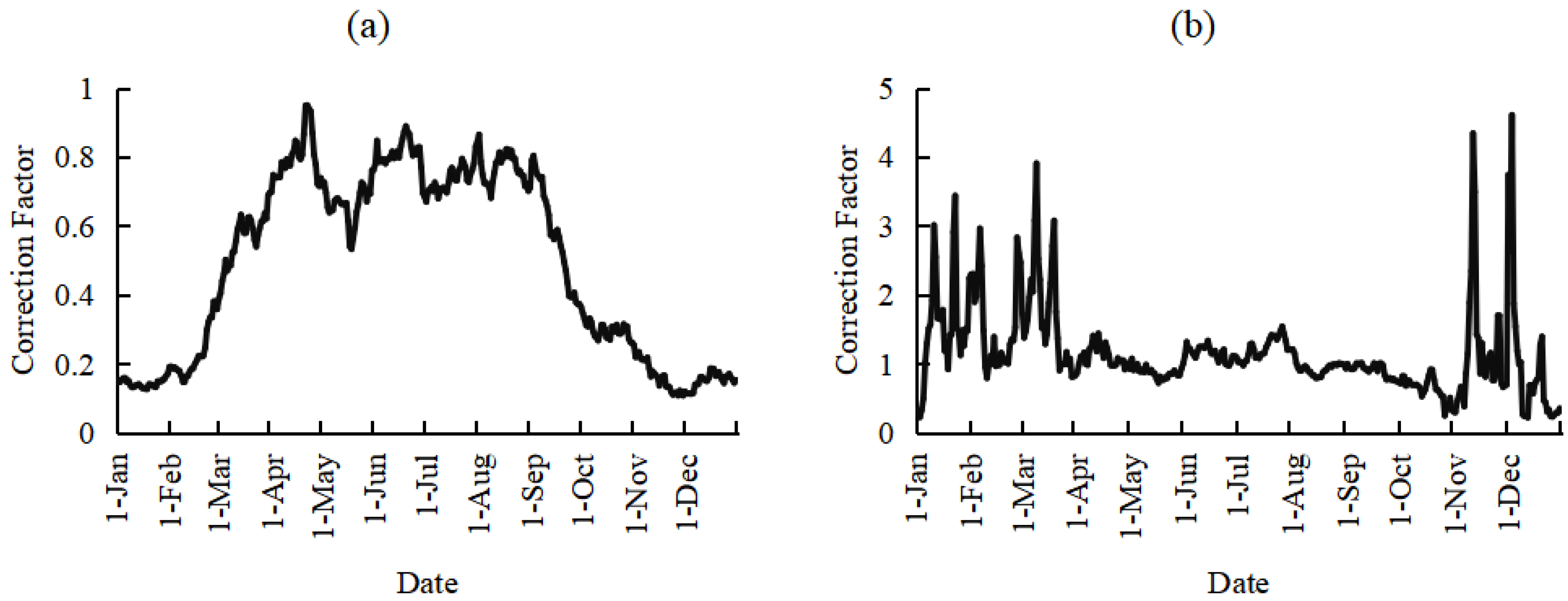
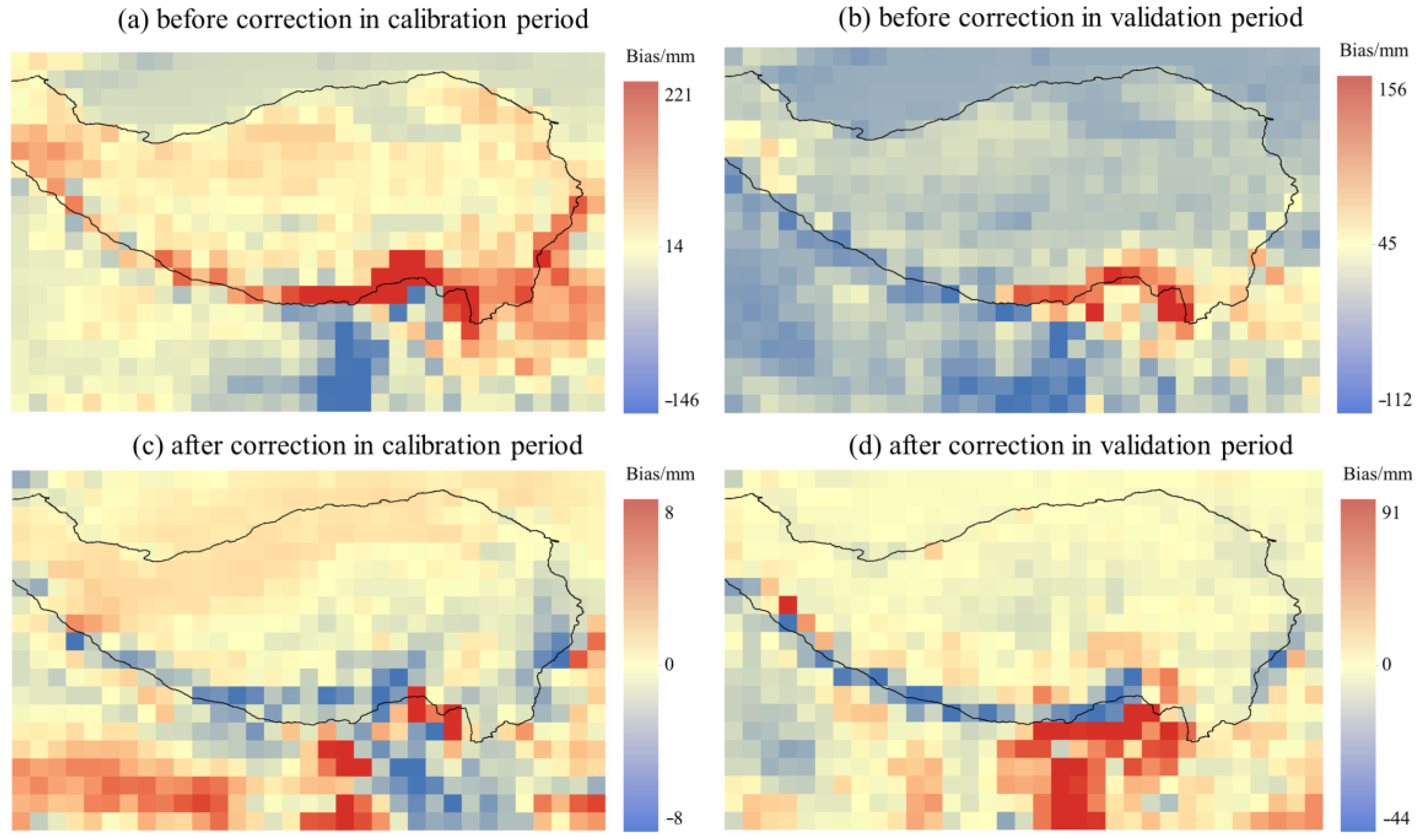
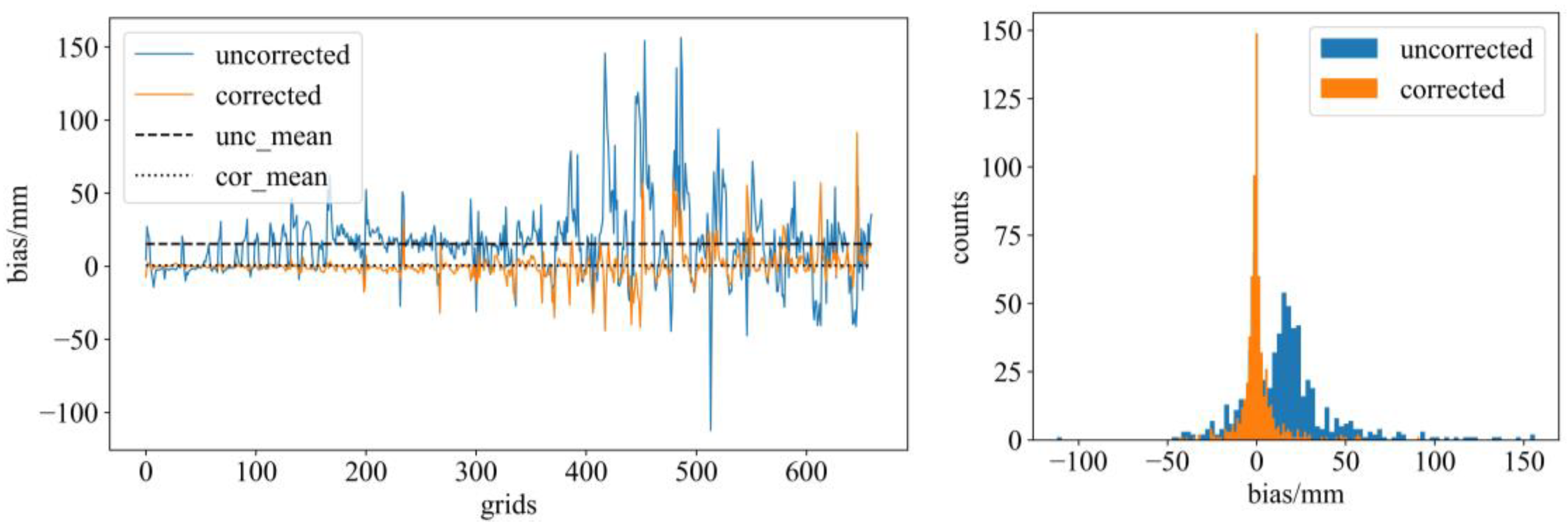
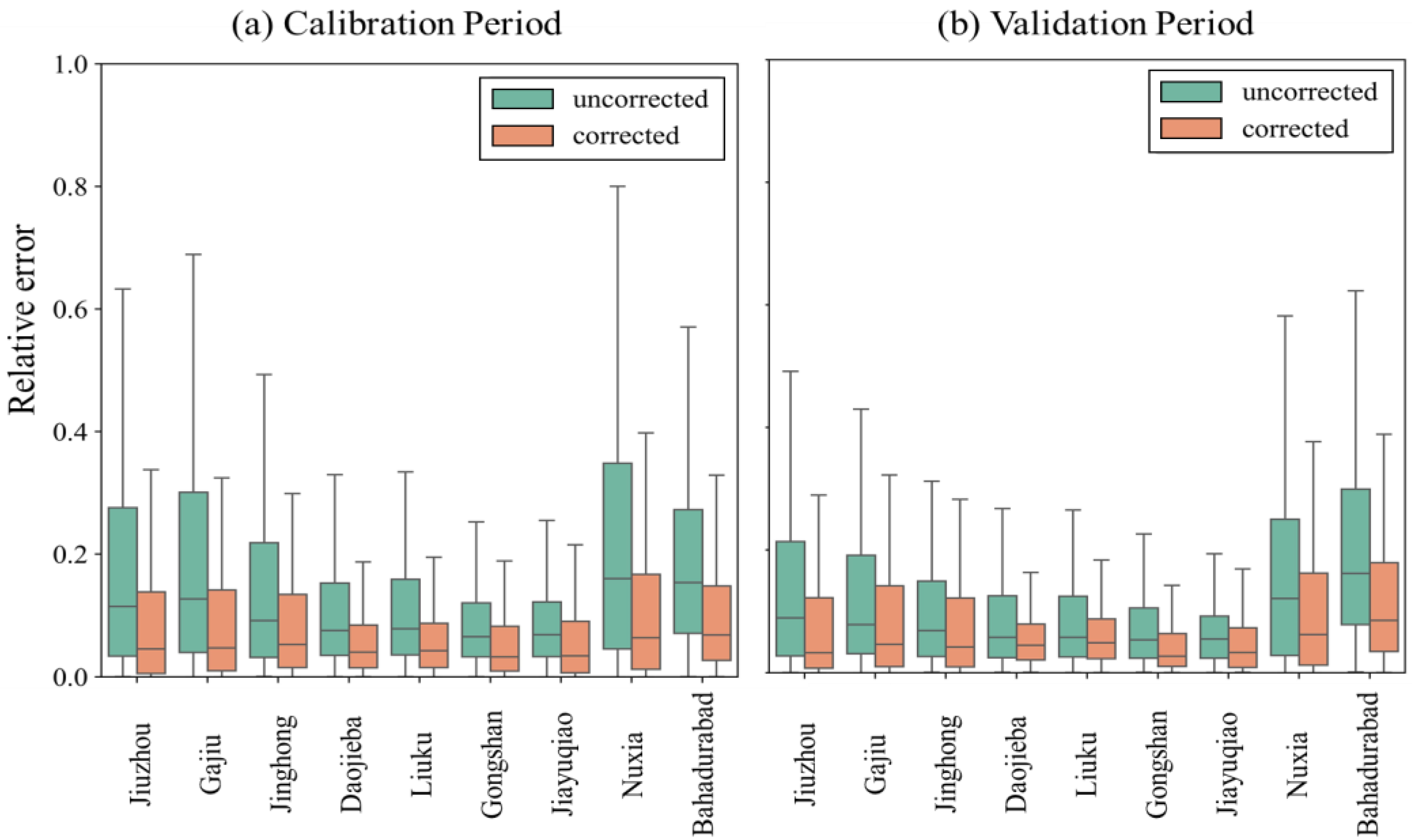
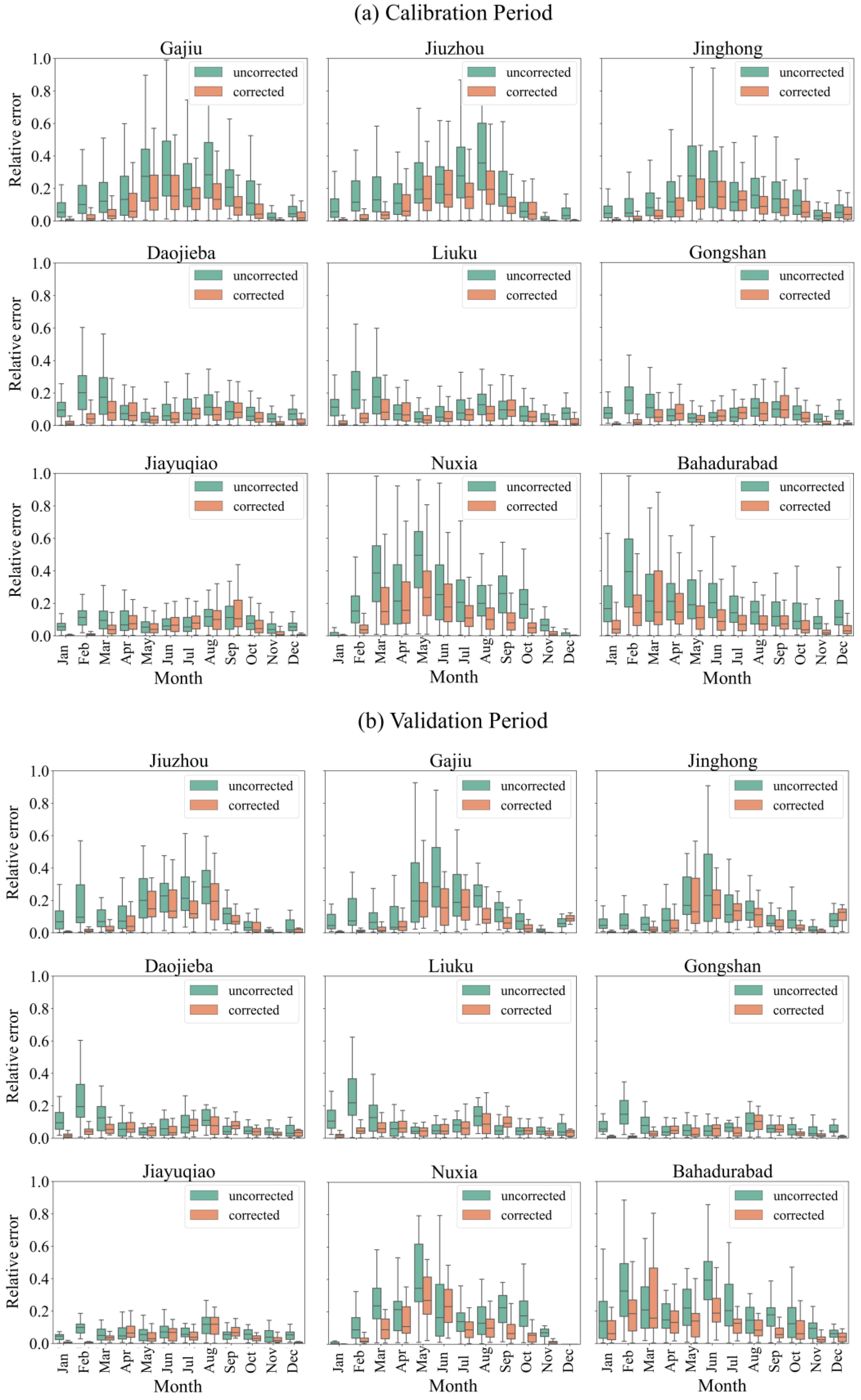
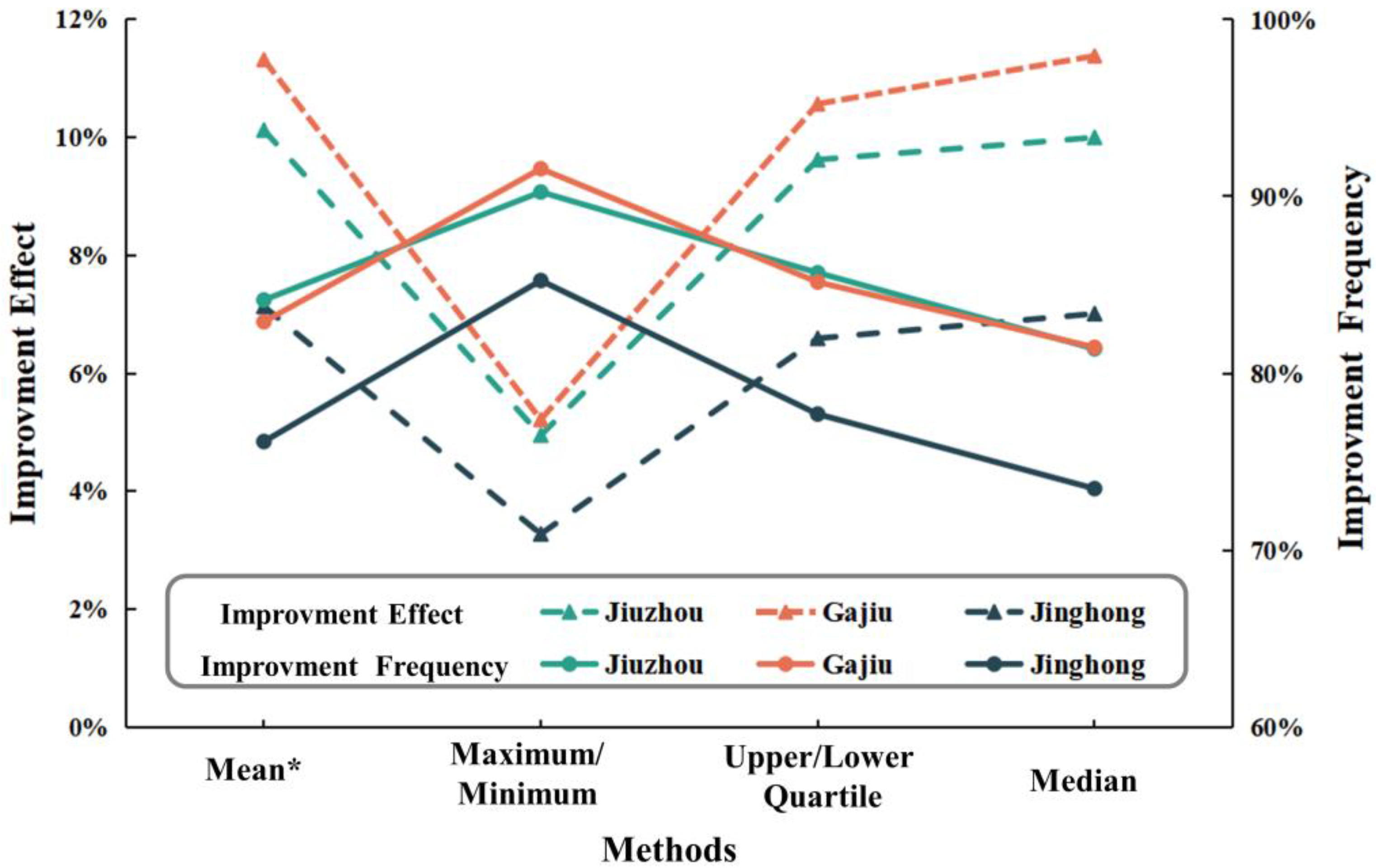
| Basin | Calibration Period | Validation Period | Stations | NSE | |
|---|---|---|---|---|---|
| Calibration | Validation | ||||
| Upper Mekong | 1991–2000 | 2001–2009 | Jiuzhou | 0.79 | 0.82 |
| Gajiu | 0.81 | 0.79 | |||
| Jinghong | 0.83 | 0.81 | |||
| Salween | 2000–2008 | 2009–2020 | Daojieba | 0.82 | 0.83 |
| Liuku | 0.78 | 0.82 | |||
| Gongshan | 0.77 | 0.73 | |||
| Jiayuqiao | 0.75 | 0.73 | |||
| Brahmaputra | 1983–2000 | 2001–2015 | Nuxia | 0.78 | 0.79 |
| Bahadurabad | 0.87 | 0.80 | |||
| Basin | Stations | Calibration Period | Validation Period | ||||
|---|---|---|---|---|---|---|---|
| Mean Relative Error (%) | IF (%) | Mean Relative Error (%) | IF (%) | ||||
| Before | After | Before | After | ||||
| Upper Mekong | Jiuzhou | 20.09 | 9.93 | 84.14 | 18.04 | 10.07 | 77.89 |
| Gajiu | 21.36 | 9.98 | 82.91 | 18.91 | 9.82 | 74.61 | |
| Jinghong | 16.43 | 9.26 | 76.14 | 19.64 | 9.58 | 65.22 | |
| Salween | Daojieba | 10.88 | 5.98 | 77.88 | 9.71 | 5.24 | 69.60 |
| Liuku | 11.19 | 6.30 | 76.19 | 10.52 | 6.81 | 68.20 | |
| Gongshan | 8.68 | 5.64 | 71.42 | 8.45 | 5.91 | 66.59 | |
| Jiayuqiao | 8.88 | 6.25 | 73.01 | 8.17 | 6.02 | 65.64 | |
| Brahmaputra | Nuxia | 25.32 | 9.58 | 91.49 | 20.43 | 9.45 | 85.72 |
| Bahadurabad | 20.37 | 8.36 | 88.18 | 21.08 | 10.43 | 82.66 | |
Disclaimer/Publisher’s Note: The statements, opinions and data contained in all publications are solely those of the individual author(s) and contributor(s) and not of MDPI and/or the editor(s). MDPI and/or the editor(s) disclaim responsibility for any injury to people or property resulting from any ideas, methods, instructions or products referred to in the content. |
© 2025 by the authors. Licensee MDPI, Basel, Switzerland. This article is an open access article distributed under the terms and conditions of the Creative Commons Attribution (CC BY) license (https://creativecommons.org/licenses/by/4.0/).
Share and Cite
Tudaji, M.; Tian, F.; Zhang, K.; Lyu, H. Evaluation and Bias Correction of ECMWF Extended-Range Precipitation Forecasts over the Confluence of Asian Monsoons and Westerlies Using the Linear Scaling Method. Hydrology 2025, 12, 218. https://doi.org/10.3390/hydrology12080218
Tudaji M, Tian F, Zhang K, Lyu H. Evaluation and Bias Correction of ECMWF Extended-Range Precipitation Forecasts over the Confluence of Asian Monsoons and Westerlies Using the Linear Scaling Method. Hydrology. 2025; 12(8):218. https://doi.org/10.3390/hydrology12080218
Chicago/Turabian StyleTudaji, Mahmut, Fuqiang Tian, Keer Zhang, and Haoyang Lyu. 2025. "Evaluation and Bias Correction of ECMWF Extended-Range Precipitation Forecasts over the Confluence of Asian Monsoons and Westerlies Using the Linear Scaling Method" Hydrology 12, no. 8: 218. https://doi.org/10.3390/hydrology12080218
APA StyleTudaji, M., Tian, F., Zhang, K., & Lyu, H. (2025). Evaluation and Bias Correction of ECMWF Extended-Range Precipitation Forecasts over the Confluence of Asian Monsoons and Westerlies Using the Linear Scaling Method. Hydrology, 12(8), 218. https://doi.org/10.3390/hydrology12080218





